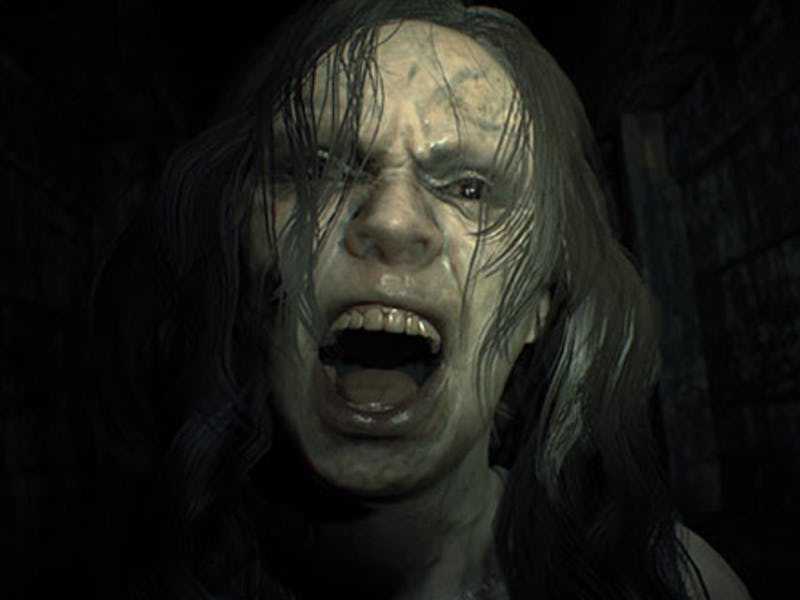5 years ago, one bold choice saved a dying horror game franchise
Resident Evil truly became pants-shittingly scary.

The fifth anniversary of Resident Evil 7: Biohazard arrived this week, marking a momentous occasion for a game that changed the series forever. Prior to this game’s release, the franchise was waffling quite a bit, unable to match or top the groundbreaking Resident Evil 4. The franchise had always been an awkward and claustrophic over-the-shoulder shooter, but as it moved more towards action, it lost its keen pacing and suspense. On the heels of the disaster known as Resident Evil 6, the next mainline entry was a make-or-break launch for Capcom. Somehow, it not only brought the series back to its roots in a whole new perspective, but it surpassed expectations, serving as one of the best Resident Evil games of all time.
Spoilers for Resident Evil 7 follow.
A new perspective
Resident Evil 7’s scare factor is attributed to its first-person perspective.
The main criticism of the series before the launch of Resident Evil 7 is that it no longer felt scary. It was clear Capcom needed the next entry to not only be scary, but more frightening than ever before. Sure, RE7 could have been yet another third-person horror game, but instead, Capcom came out of the gate swinging with a perspective shift, converting to first-person for this entry.
This was huge. It almost made up for the previous two installments. Naturally, a game in first-person is typically more immersive than if it were presented in third-person. This is because it’s easier to place yourself in the shoes of the character. When scary things happen to protagonist Ethan Winters, they’re — by extension — happening to you.
It probably would have been good, even great, if it were in third-person, but Capcom made a bold statement by changing the presentation of its long-running series. It was a risk that paid off. Resident Evil 7 starts off with a bang, bolstered by its first-person perspective.
Within the first 20 minutes of the game, the main character’s hand is severed, he gets stabbed, and is absolutely terrorized by his partner, Mia. The impact of this section cannot be overstated, due in part to the way it’s presented. It’s tough to get through that segment without clutching your wrist, which might not happen if it kept the third-person presentation from previous installments. The visceral reaction is basically a horrifying motif.
A greater emphasis on tension
The Baker family is genuinely terrifying.
Regardless of perspective, Resident Evil 7 works because it emphasizes tension and survival.
The previous two entries notoriously threw wave after wave of enemies at you, making the overall experience feel diluted with little to no tension. RE7 harkens back to the original with tight, narrow corridors, limited supplies, and enemies who feel genuinely threatening. RE5 and RE6 by comparison felt like cheap Gears of War clones.
There’s a beloved trope in Resident Evil that involves an unstoppable enemy that constantly follows you around — a trope that wasn’t featured as prominently in the previous two entries. Resident Evil 7 reintroduces this mechanic with the Baker family, featuring an invulnerable character, Jack, who chases you around the house. Knowing that Jack can pop up at any moment ensures that you’re always on the edge of your seat, taking away your control and making the game feel tense.
Preserving the franchise’s DNA
Items and puzzles are integral to the RE7 experience.
Even with all these changes, Resident Evil 7 feels like Resident Evil. Though within the first hour or so, you might not know it. The perspective shift and serious tone might be offputting to longtime fans, but after the first hour, things start to click and feel exactly like Resident Evil.
One example is the way items are handled. You can select an item to examine it, with the ability to discover a hidden feature, just like in previous installments. Grab a lamp, rotate it on its head, and discover a hidden button that unlocks a secret passage.
In addition, this game is focused on puzzles that are challenging, but rewarding, which was missing from the previous two entries. A fan-favorite puzzle requires you to rotate an item to get it to match the silhouette of a painting on the wall, such as a spider or hawk. Interacting with items in this way is so deeply tied to the Resident Evil formula, but also introduces a new take on the familiar idea.
It’s also hard to discuss Resident Evil 7 without at least mentioning the PSVR edition, which allows you to play the entire game in virtual reality. Even to this day, it’s still one of the best VR experiences, upping the ante in the horror department, with immersion at the forefront. If you have a PSVR headset, Resident Evil 7 is a must-play experience.
In many ways, Resident Evil 7 paved the way for the series, serving as a turning point that brought many fans back. Its success is clear, leading to over 10 million copies sold as of October 2021. This entry revitalized the franchise and has reinvigorated interest in horror games as a whole.